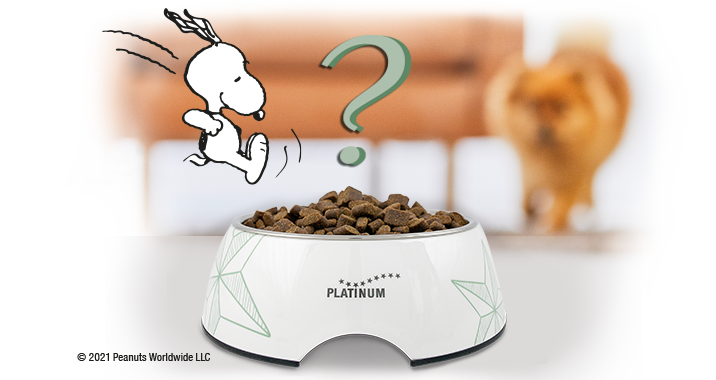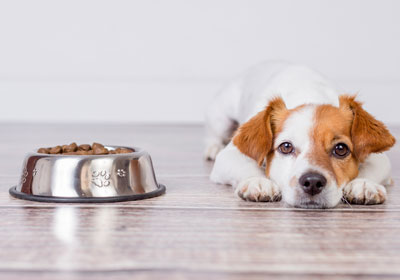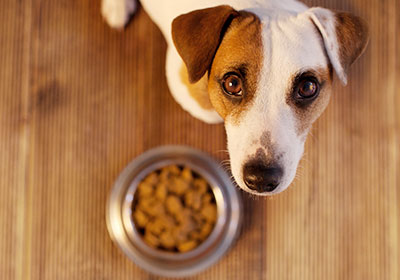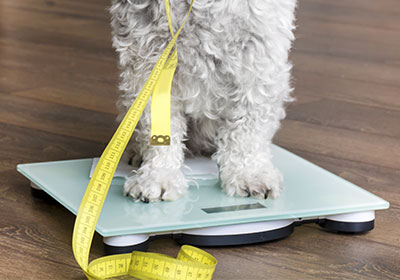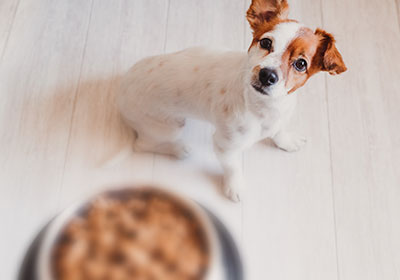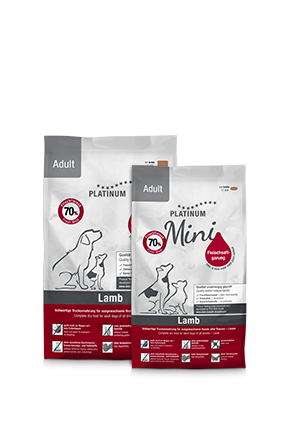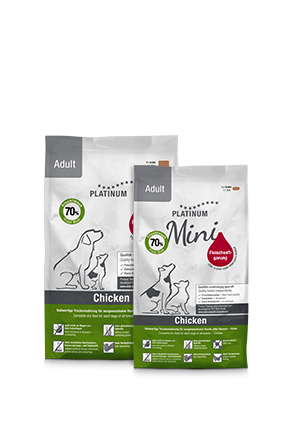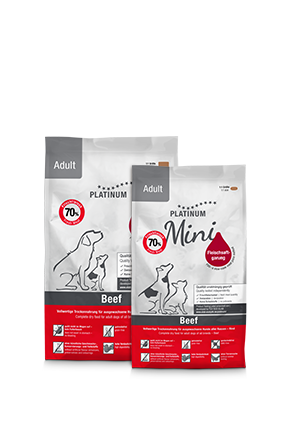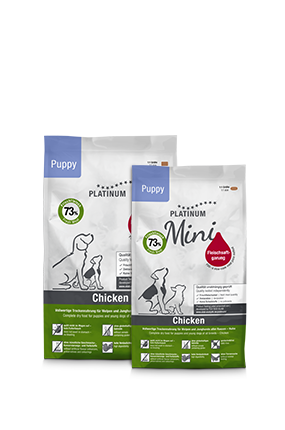Gastric torsion – lower risk with PLATINUM
‘Gastric torsion’ definition
Gastric torsion or, more precisely, gastric torsion complex is a life-threatening, often dramatic disease that, if left untreated, usually leads to death within a very short time. Gastric torsion is particularly common in large and deep-breasted dog breeds, but it can also occur in medium-sized and small dogs. Dogs between 5 and 9 years old are most likely to be affected.
With gastric torsion, the dog’s stomach turns on its own axis. In the process, supplying and draining blood vessels as well as the stomach inlet and outlet (transitions to the oesophagus and intestines) are cut off. The blood supply is interrupted, and the stomach becomes bloated, which quickly leads to blood congestion in the abdominal organs and subsequently to circulatory collapse.
Symptoms
The symptoms are very typical and appear a few hours after feeding. The massively ‘bloated’, hard belly is striking. The dogs are restless at first, then later usually apathetic. The rapidly deteriorating general condition is accompanied by panting and retching, increased salivation and strained breathing. If treatment is too late or not given at all, death can quickly result. The survival rate after surgery depends on how quickly the gastric torsion is recognised and treated surgically. For a relatively high percentage of dogs, any help comes too late.1
Risk factors for gastric torsion
It is often assumed that the interaction of various risk factors triggers the disease:
- the size of the dog is considered a risk factor for gastric torsion. Large and giant breeds are affected significantly more often.2
- An association with a deep, narrow chest and a familial cluster of affected dogs could be identified.
- Many studies have associated increasing age with risk.3
- Age-related loosening of the stomach suspension, delayed gastric emptying times and impaired stomach movements are also possible risk factors.
- Gastric torsion is also triggered by fermenting dog food, which often causes stomach bloating. In addition, excessive air swallowing, for example in the course of eating, leads to increased gas accumulation in the stomach.
- Even the administration of a single, large meal can lead to an increased risk of disease.4
- Playing and jumping shortly after eating is another risk factor.
How do I respond?
If your dog shows typical symptoms of gastric distress (bloated abdomen, restlessness, panting, retching, shortness of breath, pale mucous membranes), you should definitely not wait to see if its condition improves. Now every minute is vital! Anyone who owns a dog with an increased likelihood of gastric distress should identify two vets in their area who are available at all times of the day and night. It is important that they are able to perform an appropriate surgical intervention. However, not every family veterinarian is able to do this. If gastric torsion is suspected, your own emergency measures are not an option. The dog must receive immediate veterinary care.
What does the vet do in case of gastric torsion?
If a dog is brought in with suspected gastric torsion, an x-ray is usually taken for diagnosis. If the suspicion is confirmed, an attempt can be made to release excess gases via a tube through the throat or a cannula through the abdominal wall. Under certain circumstances, this procedure can cause the stomach to turn back on its own. Otherwise, a complex operation is necessary in which the abdominal wall is opened, and the stomach is brought back into its original position. The longer the stomach has been turned, the more likely it is that parts of the stomach or spleen are already damaged and need to be removed. Before the vet closes the abdominal wall again, the stomach is usually attached to the abdominal wall with sutures to prevent the stomach from twisting again.
Prevention
There is no single cause of gastric torsion, but rather a combination of factors. Therefore, the following points are a recommendation, but not a 100% guarantee:
- For prevention, dogs at risk in particular should be fed 2-3 times a day at fixed times. Especially in the evening, only a small amount of food should be given.
- Give your dog sufficient rest after feeding and minimise stress factors.
- Hasty food intake and the associated air swallowing should be avoided or at least reduced (e.g. with the help of an anti-gulp bowl).
- Hygienic handling of food is important, as bacterially contaminated food can lead to faulty fermentation.
What food should my dog eat after gastric torsion?
Conventional dry food often consists of a large proportion of poorly digestible grain. Due to this ingredient and the extruder production under pressure and high heat, a starch layer forms around the individual croquettes, which must first be broken down in the dog’s stomach. As a result, the dog food swells several times in the dog’s stomach, is digested more slowly and can thus cause flatulence. Test it for yourself: simply pour warm water over conventional dry food.
Unlike conventional dry food, PLATINUM dry food does not swell up in the stomach and your dog does not get a bloated belly after eating it. The gastrointestinal passage is much faster – and the stomach is relieved. This significantly reduces the risk of gastric torsion. Even the rest after eating can be significantly shorter.
Product recommendation
1Hellweg P. & Zentek J. (2005). Risikofaktoren im Zusammenhang mit der Magendrehung des Hundes. Kleintierpraxis, 50(10), 611-620.
2Hellweg P. & Zentek J. (2005). Risikofaktoren im Zusammenhang mit der Magendrehung des Hundes. Kleintierpraxis, 50(10), 611-620.
3Elwood C. (1998). Risk factors for gastric dilatation in Irish setter dogs, J Small Anim Pract, 39, 185-190.
4Raghavan, M., Glickman N., McCabe G., Lantz G., Glickman L. T. (2004): Diet-related risk factors for gastric dilatation-volvulus in dogs of high-risk breeds. J Am Anim Hosp Assoc, 40, 192–203.
The benefits of PLATINUM dog food
- PLATINUM uses a unique preparation method called FSG, which offers numerous advantages compared to conventional dog food.
- Dog food prepared with FSG is gently cooked only in its own meat juice and is therefore nutrient-rich like BARF, excellent for building muscles and also extra tasty for your dog.
- With at least 70% fresh meat in the dry dog food and 83% fresh meat or fresh fish in the wet dog food, PLATINUM places great value on a composition of the food that is adapted to the needs of dogs.
- The declaration and composition of dog food prepared with FSG is tested regularly and independently by ELAB Analytik GmbH (formerly TÜV SÜD ELAB) — for canine health protection.
- PLATINUM is generally very well accepted by dogs of all breeds and ages. Even four-legged friends with sensitive digestion or intolerances usually tolerate PLATINUM dog food well.
- All products are free of soya, GMOs and gluten. In addition, no flavour enhancers, attractants, odourants or colourings are used.
- Over 100,000 positive customer reviews at Trusted Shops speak for themselves!


 Deutsch
Deutsch
 English
English
 Nederlands
Nederlands
 Français
Français

